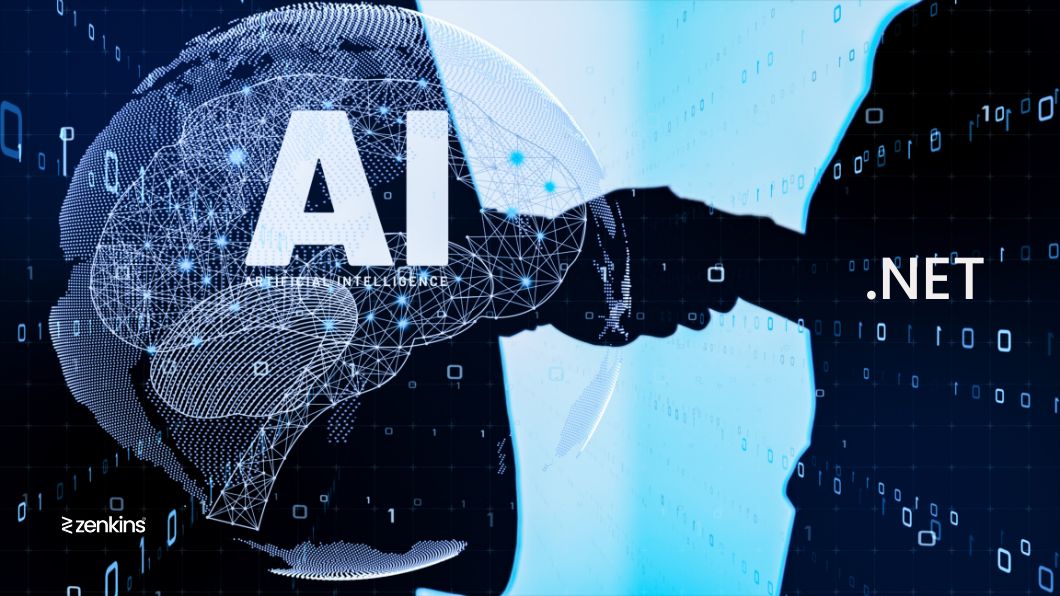Integrating AI with .NET: A Developer’s Guide to Smarter Applications
Table of Contents
As the digital landscape continues to evolve, the integration of artificial intelligence (AI) within application development has become more than just a trend—it’s a necessity. For developers using Microsoft’s .NET framework, the potential to create intelligent applications has never been more accessible. In this comprehensive guide, we’ll explore how you can leverage AI in .NET to build smarter, more responsive, and efficient applications that meet the demands of today’s tech-savvy users.
Why Integrating AI with .NET Matters
The marriage of AI and .NET opens up a world of possibilities for developers. By integrating AI into your .NET applications, you can:
- Enhance User Experience: AI can analyze user behavior and preferences to create more personalized and intuitive interactions.
- Automate Routine Tasks: AI algorithms can handle repetitive tasks, freeing up developers to focus on more complex challenges.
- Improve Decision-Making: With AI-driven insights, applications can make data-driven decisions in real-time, boosting efficiency.
- Predict and Analyze Trends: AI can analyze large datasets to predict trends and provide actionable insights, which is particularly valuable for business applications.
Getting Started with AI in .NET
Integrating AI with .NET starts with understanding the tools and libraries available to you. Microsoft provides a robust ecosystem for AI development within the .NET framework, making it easier to integrate machine learning models, natural language processing, computer vision, and more.
1. Microsoft AI and Machine Learning Tools
- ML.NET: ML.NET is a cross-platform, open-source machine learning framework designed for .NET developers. It allows you to build, train, and deploy custom machine learning models with ease.
- Azure Cognitive Services: Azure Cognitive Services offers pre-built APIs for AI functionalities like vision, speech, language, and decision-making. These services can be easily integrated into .NET applications to add AI capabilities without needing deep AI expertise.
2. Understanding Machine Learning in .NET
Machine learning (ML) is at the heart of AI integration. In .NET, ML.NET provides a comprehensive environment to work with various ML models. Here’s a breakdown of how to get started:
a) Data Preparation
- Data Collection: Before you can train any model, you need to collect and prepare data. .NET offers various libraries such as Entity Framework and ADO.NET to interact with databases and retrieve the necessary data.
- Data Preprocessing: Once collected, your data might require cleaning, normalization, and transformation. ML.NET provides tools to preprocess data and make it ready for model training.
b) Model Training
- Choose an Algorithm: ML.NET supports various algorithms like linear regression, classification, clustering, and more. The choice of algorithm depends on the problem you’re trying to solve.
- Train the Model: Training involves feeding data into the algorithm to learn from it. With ML.NET, you can write a few lines of code to train your model on your dataset.
c) Model Evaluation and Tuning
- Evaluate Model Performance: After training, it’s crucial to evaluate the model’s performance using metrics like accuracy, precision, recall, and F1 score.
- Model Tuning: Fine-tuning involves adjusting hyperparameters to optimize model performance. ML.NET allows you to easily experiment with different configurations.
d) Model Deployment
- Integrate into .NET Applications: Once the model is trained and optimized, it can be integrated into your .NET application to start making predictions.
- Continuous Learning: Models can be updated and retrained as more data becomes available, ensuring that your application remains relevant and accurate over time.
3. Natural Language Processing (NLP) with .NET
Natural Language Processing (NLP) is a subfield of AI that enables machines to understand and interpret human language. In .NET, you can leverage the power of NLP to build applications that interact with users more naturally.
a) Using Azure Cognitive Services for NLP
- Text Analytics API: This API provides a suite of tools for analyzing text, including sentiment analysis, key phrase extraction, and language detection. Integrating it into a .NET application is straightforward and can add valuable features like real-time sentiment analysis.
- Language Understanding (LUIS): LUIS helps build custom language models that can understand user intents and extract information from text. It’s particularly useful for creating chatbots and virtual assistants within .NET applications.
b) Implementing Chatbots in .NET
- Bot Framework SDK: Microsoft’s Bot Framework SDK for .NET allows you to build sophisticated chatbots that can interact with users via various channels like Microsoft Teams, Slack, and Facebook Messenger.
- Integrating AI Models: By combining NLP models with the Bot Framework, you can create chatbots that not only respond to queries but also understand context, provide recommendations, and carry out tasks.
4. Computer Vision in .NET
Computer vision enables applications to interpret and make decisions based on visual data. .NET developers can integrate computer vision to enhance user experiences in applications that require image recognition, object detection, and more.
a) Azure Computer Vision API
- Image Analysis: The Azure Computer Vision API provides tools for analyzing images to extract information, such as identifying objects, reading text (OCR), and recognizing faces.
- Custom Vision: If you need more tailored image recognition capabilities, Azure’s Custom Vision service allows you to train custom models specific to your use case. These models can then be integrated into your .NET application.
b) Integrating Vision Models with .NET Applications
- Real-Time Analysis: Integrate vision models into applications that require real-time image processing, such as surveillance systems, medical imaging, or augmented reality.
- Image Classification: Use vision models for tasks like categorizing images in large datasets or automating the sorting and tagging of visual content.
5. AI-Driven Decision Making in .NET
Integrating AI into .NET applications isn’t just about adding cool features; it’s about making applications smarter and more responsive. AI-driven decision-making can help applications optimize processes, reduce errors, and make better recommendations.
a) Recommendation Systems
- Collaborative Filtering with ML.NET: Collaborative filtering is a technique used in recommendation systems. ML.NET makes it easy to implement this in .NET applications, enabling personalized recommendations based on user behavior and preferences.
- Content-Based Filtering: Another approach is content-based filtering, where the system recommends items similar to those the user has interacted with. This can be implemented using a combination of NLP and machine learning models in .NET.
b) Predictive Analytics
- Time Series Forecasting: Use ML.NET to create models that can predict future trends based on historical data, such as sales forecasts, stock prices, or customer demand.
- Anomaly Detection: Integrate anomaly detection models to monitor and identify unusual patterns in data, which is particularly useful in fraud detection, system monitoring, and quality control.
6. Best Practices for Integrating AI with .NET
While integrating AI into .NET applications offers numerous benefits, it’s essential to follow best practices to ensure the success of your projects.
a) Data Privacy and Security
- Compliance: Ensure that your AI solutions comply with data privacy regulations like GDPR or CCPA. This is especially important when dealing with sensitive information like personal data or financial records.
- Secure Data Storage: Use encryption and other security measures to protect the data used by AI models, both at rest and in transit.
b) Model Interpretability
- Explainable AI: As AI models become more complex, it’s crucial to ensure that their decisions are interpretable by humans. ML.NET provides tools for understanding how models make decisions, which is particularly important in sectors like healthcare and finance.
c) Scalability
- Cloud Integration: For large-scale AI applications, consider integrating your .NET application with cloud services like Azure, which offers scalability, high availability, and robust infrastructure to support AI workloads.
- Efficient Resource Management: Optimize the use of computational resources to ensure that your AI models run efficiently, especially in real-time applications.
7. Challenges and Considerations
While integrating AI with .NET presents numerous opportunities, it also comes with challenges that developers need to consider.
a) Model Maintenance
- Continuous Improvement: AI models require regular updates to maintain their accuracy and relevance. Plan for ongoing maintenance and retraining of models as part of your development lifecycle.
- Version Control: Implement version control for your AI models to track changes and roll back to previous versions if necessary.
b) Skill Gap
- Learning Curve: Integrating AI with .NET might require learning new concepts and tools. Invest in training and development to equip your team with the necessary skills.
- Collaboration: Encourage collaboration between data scientists and .NET developers to bridge the gap between AI and traditional software development.
c) Ethical Considerations
- Bias in AI: Be mindful of potential biases in AI models, especially those related to gender, race, or socioeconomic factors. Use diverse and representative datasets to train your models.
- Transparency: Ensure transparency in how AI models make decisions, especially in applications that impact users’ lives significantly.
Conclusion
Integrating AI with .NET is a powerful way to build smarter, more responsive applications that can meet the demands of today’s users. Whether you’re working with machine learning, natural language processing, computer vision, or decision-making models, the .NET ecosystem provides the tools and resources you need to succeed.
However, successful integration of AI into .NET applications requires more than just technical know-how. It involves careful consideration of data privacy, model interpretability, scalability, and ethical implications. By adhering to best practices and being mindful of the challenges, you can create AI-driven .NET applications that not only perform well but also foster trust and transparency with your users.
Final Thoughts
As AI continues to evolve, its integration with .NET will likely become a standard practice in software development. Developers who embrace this trend will be better positioned to innovate and deliver solutions that stand out in a competitive market.
By following this guide, you can begin your journey toward integrating AI with .NET, transforming your applications into intelligent systems capable of making data-driven decisions, automating tasks, and delivering personalized user experiences. Whether you’re a seasoned .NET developer or new to AI, the opportunities to create smarter applications are vast and growing. So, take the leap, experiment with the tools available, and start building the future of software development today.
FAQs
What is the importance of integrating AI with .NET?
Integrating AI with .NET enhances application intelligence, automates tasks, and improves user experience and decision-making.
What tools are available for AI integration in .NET?
Tools include ML.NET, Azure Cognitive Services, and Microsoft Bot Framework, among others.
How can I get started with machine learning in .NET?
Start by using ML.NET for building, training, and deploying custom machine learning models within .NET applications.
What is ML.NET, and how does it work?
ML.NET is an open-source, cross-platform machine learning framework for .NET developers to create custom AI models.
Can I integrate natural language processing (NLP) with .NET?
Yes, you can integrate NLP using Azure Cognitive Services like Text Analytics API and LUIS for language understanding.
What is the Bot Framework SDK, and how is it used in .NET?
The Bot Framework SDK allows developers to build chatbots in .NET that can interact with users on multiple platforms.
How can I implement computer vision in my .NET applications?
Use Azure Computer Vision API for image analysis or Custom Vision for tailored image recognition models.
What are the best practices for integrating AI with .NET?
Best practices include ensuring data privacy, maintaining model interpretability, and optimizing for scalability.
What challenges might I face when integrating AI with .NET?
Challenges include model maintenance, skill gaps, ethical considerations, and managing data privacy.
How do I handle data privacy when integrating AI into .NET?
Ensure compliance with regulations like GDPR, and use secure data storage and encryption methods.
What is model interpretability, and why is it important?
Model interpretability ensures that AI decisions are understandable by humans, crucial for sectors like healthcare and finance.
How do I scale AI applications in .NET?
Use cloud services like Azure for scalable infrastructure and efficient resource management.
What is the role of Azure Cognitive Services in AI integration with .NET?
Azure Cognitive Services provide pre-built AI APIs for vision, speech, language, and decision-making, easily integrated into .NET.
How can I implement a recommendation system in .NET using AI?
Use collaborative filtering or content-based filtering with ML.NET to create personalized recommendations.
How can I ensure ethical AI integration in .NET applications?
Be mindful of biases, ensure transparency, and use diverse datasets to train AI models responsibly.
What is the role of continuous learning in AI models within .NET?
Continuous learning involves updating and retraining models as more data becomes available to keep them relevant and accurate.
How can AI-driven decision-making improve my .NET applications?
AI-driven decision-making helps optimize processes, reduce errors, and enhance user satisfaction with data-driven insights.
Can I integrate AI with existing .NET applications, or do I need to start from scratch?
You can integrate AI with existing .NET applications by adding AI models and using tools like ML.NET and Azure services.
What are the common use cases for AI in .NET applications?
Common use cases include chatbots, predictive analytics, recommendation systems, image recognition, and natural language processing.
How does AI in .NET impact the future of software development?
AI in .NET drives innovation, enabling the development of smarter, more responsive, and efficient applications that meet modern user demands.
What does integrating AI with .NET mean?
It refers to incorporating artificial intelligence capabilities within .NET applications using tools and libraries that enable machine learning, natural language processing, computer vision, and more.
Why should I integrate AI with .NET?
Integrating AI with .NET enhances application functionality, automates tasks, improves user experience, and provides data-driven insights that can lead to smarter applications.
What are the key benefits of using AI in .NET applications?
Benefits include personalized user experiences, real-time decision-making, automation of routine tasks, and enhanced data analytics.
Which AI tools are compatible with .NET?
Key tools include ML.NET, Azure Cognitive Services, and the Bot Framework SDK, all of which are designed to work seamlessly with .NET.
Can I use machine learning with .NET?
Yes, ML.NET is specifically designed for .NET developers to build, train, and deploy machine learning models within .NET applications.
How do I start integrating AI with .NET?
Begin by identifying the AI functionality needed, such as machine learning or NLP, and then use tools like ML.NET or Azure Cognitive Services to implement those features in your .NET application.
What is ML.NET, and how is it used in .NET?
ML.NET is a cross-platform, open-source machine learning framework that allows developers to create custom AI models for .NET applications.
How can I integrate NLP into a .NET application?
You can integrate NLP using Azure Cognitive Services APIs, such as Text Analytics for sentiment analysis or LUIS for understanding user intents.
What is the role of Azure Cognitive Services in AI integration with .NET?
Azure Cognitive Services provides pre-built AI APIs for tasks like image recognition, speech-to-text, and language understanding, which can be easily integrated into .NET applications.
How do I integrate computer vision capabilities into a .NET application?
Use the Azure Computer Vision API to add image analysis, object detection, and OCR capabilities to your .NET applications.
Can I build chatbots with AI in .NET?
Yes, Microsoft’s Bot Framework SDK for .NET allows you to create AI-powered chatbots that can interact with users across various platforms.
What are the challenges of integrating AI with .NET?
Challenges include managing data privacy, ensuring model interpretability, overcoming skill gaps, and addressing ethical concerns related to AI.
How do I ensure data privacy when using AI in .NET?
Implement encryption, adhere to data protection regulations like GDPR, and use secure cloud services to protect sensitive information.
What is the best way to deploy AI models in a .NET application?
After training and optimizing your AI model, integrate it into your .NET application, and consider deploying it using Azure for scalability and reliability.
How can AI in .NET improve decision-making in applications?
AI can analyze vast amounts of data in real-time, enabling applications to make accurate, data-driven decisions quickly and efficiently.
What are the ethical considerations when integrating AI with .NET?
Consider the potential biases in AI models, ensure transparency in AI decisions, and adhere to ethical guidelines when developing AI-powered applications.
Can AI models be retrained within .NET applications?
Yes, with ML.NET, you can continuously update and retrain models as new data becomes available, ensuring your application stays relevant.
What types of applications can benefit from AI integration in .NET?
Applications in industries like finance, healthcare, retail, and customer service can greatly benefit from AI integration, enhancing everything from user interaction to operational efficiency.
How does AI integration affect the performance of .NET applications?
While AI can add computational overhead, optimizing models and using scalable cloud solutions can mitigate performance impacts and improve overall efficiency.
What is the future of integrating AI with .NET?
The future lies in more seamless integration, with AI becoming a standard part of .NET development, enabling smarter, more adaptive applications that meet the evolving needs of users.




